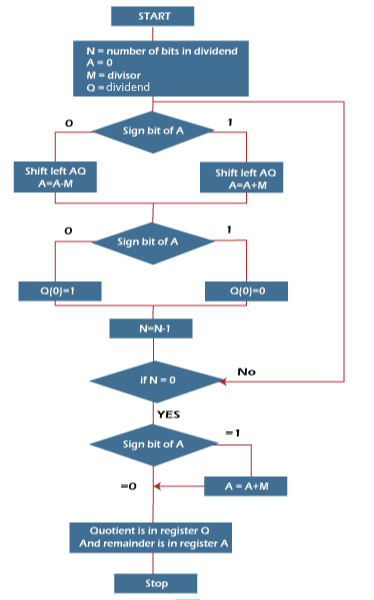COA Tutorial
Basic CO and Design
Computer Instructions
Digital Logic Circuits
Map Simplification
Combinational Circuits
Flip - Flops
Digital Components
Register Transfer
Micro-Operations
Memory Organization
COA_Misc
- Booth's Multiplication Algorithm
- Branch Instruction in Computer Organization
- Data Representation in Computer Organization
- ALU and Data Path in Computer Organization
- External memory in Computer Organization
- Structured Computer Organization
- Types of Register in Computer Organization
- Secondary Storage Devices in Computer Organization
- Types of Operands in Computer Organization
- Serial Communication in Computer organization
- Addressing Sequencing in Computer Organization
- Simplified Instructional Computer (SIC)
- Arithmetic Instructions in AVR microcontroller
- Conventional Computing VS Quantum Computing
- Instruction set used in Simplified Instructional Computer
- Branch Instruction in AVR microcontroller
- Conditional Branch instruction in AVR Microcontroller
- Data transfer instruction in AVR microcontroller
- Difference between Memory-based and Register-based addressing modes
- Difference between 1's complement Representation and 2's complement Representation
- CALL Instructions and Stack in AVR Microcontroller
- Difference between Call and Jump Instructions
- Overflow in Arithmetic Addition in Binary number System
- Horizontal Micro-programmed Vs. Vertical Micro-programmed Control Unit
- Hardwired Vs. Micro-programmed Control Unit
- Non-Restoring Division Algorithm for Unsigned Integer
- Restoring Division Algorithm for Unsigned Integer
- Debugging a Machine-level Program
- Dependencies and Data Hazard in pipeline in Computer Organization
- Execution, Stages and Throughput in Pipeline
- Types of Pipeline Delay and Stalling
- Timing Diagram of MOV Instruction
- Advantages and Disadvantages of Flash Memory
- Importance/Need of negative feedback in amplifiers
- Anti-Aliasing - Computer Graphics
- Bus Arbitration in Computer Organization
- Convert a number from Base 2 (Binary) to Base 6
- Cache Coherence
- EHCI
- Cache Memory and Virtual Memory
- Electrical Potential and Potential Difference
- RAM and Cache
- SIM and RIM instructions in 8085 processor
- Clusters in Computer Organization
- Data Types and Addressing Modes of 80386/80386DX Microprocessor
Non-Restoring Division Algorithm for Unsigned Integer
Instead of the quotient digit set {0, 1}, the set {-1, 1} is used by the non-restoring division. The non-restoring division algorithm is more complex as compared to the restoring division algorithm. But when we implement this algorithm in hardware, it has an advantage, i.e., it contains only one decision and addition/subtraction per quotient bit. After performing the subtraction operation, there will not be any restoring steps. Due to this, the numbers of operations basically cut down up to half. Because of the less operation, the execution of this algorithm will be fast. This algorithm basically performs simple operations such as addition, subtraction. In this method, we will use the sign bit of register A. 0 is the starting value/bit of register A.

Now we will learn steps of the non-restoring division algorithm, which are described as follows:
Step 1: In this step, the corresponding value will be initialized to the registers, i.e., register A will contain value 0, register M will contain Divisor, register Q will contain Dividend, and N is used to specify the number of bits in dividend.
Step 2: In this step, we will check the sign bit of A.
Step 3: If this bit of register A is 1, then shift the value of AQ through left, and perform A = A + M. If this bit is 0, then shift the value of AQ into left and perform A = A - M. That means in case of 0, the 2's complement of M is added into register A, and the result is stored into A.
Step 4: Now, we will check the sign bit of A again.
Step 5: If this bit of register A is 1, then Q[0] will become 0. If this bit is 0, then Q[0] will become 1. Here Q[0] indicates the least significant bit of Q.
Step 6: After that, the value of N will be decremented. Here N is used as a counter.
Step 7: If the value of N = 0, then we will go to the next step. Otherwise, we have to again go to step 2.
Step 8: We will perform A = A + M if the sign bit of register A is 1.
Step 9: This is the last step. In this step, register A contains the remainder, and register Q contains the quotient.
For example:
In this example, we will perform a Non-Restoring Division algorithm with the help of an Unsigned integer.
- Dividend = 11
- Divisor = 3
- -M = 11101
| N | M | A | Q | Action |
|---|---|---|---|---|
| 4 | 00011 | 00000 | 1011 | Begin |
| 00011 | 00001 | 011_ | Shift left AQ | |
| 00011 | 11110 | 011_ | A = A - M | |
| 3 | 00011 | 11110 | 0110 | Q[0] = 0 |
| 00011 | 11100 | 110_ | Shift left AQ | |
| 00011 | 11111 | 110_ | A = A + M | |
| 2 | 00011 | 11111 | 1100 | Q[0] = 0 |
| 00011 | 11111 | 100_ | Shift left AQ | |
| 00011 | 00010 | 100_ | A = A +M | |
| 1 | 00011 | 00010 | 1001 | Q[0] = 1 |
| 00011 | 00101 | 001_ | Shift left AQ | |
| 00011 | 00010 | 001_ | A = A - M | |
| 0 | 00011 | 00010 | 0011 | Q[0] = 1 |
So, register A contains the remainder 2, and register Q contains the quotient 3.


